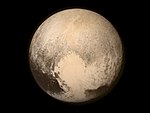astro.wikisort.org - Meteorite
K2-3d, also known as EPIC 201367065 d, is a confirmed exoplanet of probable mini-Neptune type orbiting the red dwarf star K2-3, and the outermost of three such planets discovered in the system. It is located 137 light-years (42 pc) away from Earth in the constellation of Leo.[2][4] The exoplanet was found by using the transit method, in which the dimming effect that a planet causes as it crosses in front of its star is measured. It was the first planet in the Kepler "Second Light" mission to receive the letter "d" designation for a planet. Its discovery was announced in January 2015.[1]
 Size comparison between the Earth and K2-3d. | |
| Discovery[1] | |
|---|---|
| Discovery site | Kepler Space Observatory |
| Discovery date | 2015 |
Detection method | Transit |
| Orbital characteristics | |
Semi-major axis | 0.2097+0.0065 −0.0070 AU |
| Eccentricity | 0.045 (± 0.045)[2] |
Orbital period (sidereal) | 44.55764±0.00042[3] d |
| Inclination | 89.79 (± 0.15)[2] |
| Semi-amplitude | 0.29+0.34 −0.18[3] |
| Star | K2-3 |
| Physical characteristics | |
Mean radius | 1.65±0.17[3] REarth |
| Mass | 2.7+1.2 −0.8[3] MEarth |
Mean density | 1.6+2.1 −1.0 g cm−3 |
Surface gravity | 2.89+2.39 −1.52 g |
| Temperature | 282 K (9 °C; 48 °F) |
Characteristics
Mass, radius, density and temperature
K2-3d is a super-Earth or a Mini-Neptune, meaning it has a mass and radius bigger than Earth's, but smaller than that of the ice giants Uranus and Neptune. It has a surface temperature of 282 K (9 °C; 48 °F) and a radius of 1.6 REarth. The planet is likely to be a mini-Neptune, with no solid surface.[5] While originally estimated to have a very high density,[2] recent analysis of HARPS data in 2018 have constrained the mass to less than 4 MEarth to a 1σ confidence.[3] This corresponds to a relatively low density, similar to that of Neptune, suggesting a very large volatile layer and significantly reducing the potential habitability of the world.
Host star
The planet orbits a (M-type) red dwarf star named K2-3, orbited by a total of three known planets, of which K2-3d has the longest orbital period.[1] The star has a mass of 0.60 M☉ and a radius of 0.56 R☉.[4][1] It has a temperature of 3896 K and is about 1 billion years old.[4] In comparison, the Sun is 4.6 billion years old[6] and has a surface temperature of 5778 K.[7]
The star's apparent magnitude, or how bright it appears from Earth's perspective, is 12.168.[8] Therefore, it is too dim to be seen with the naked eye.
Orbital statistics
K2-3d orbits its host star, which has about 6% of the Sun's luminosity, with an orbital period of 44 days and an orbital radius of about 0.2 times that of Earth (compared to the distance of Mercury from the Sun, which is about 0.38 AU).[4]
Habitability
The planet orbits on the edge of the inner (empirical) habitable zone, a region where, with the proper atmospheric properties and pressure, liquid water may exist on the surface of the planet. However, it is very likely tidally locked to its star, with one side facing towards its star in scorching heat, and the opposite side in bitter darkness.[9] Despite this, there is an area – the terminator line – where the surface temperatures may be comfortable enough to support liquid water. However, given that most models of the habitable zone parameters put K2-3d slightly beyond the inner edge of the habitable zone, it is likely to be too hot even at the terminator line and thus not habitable at all. Plus, the high gravity caused by the density of K2-3d would further hinder its habitability. Also, the stellar flux for the planet is an abnormally high 1.4 times that of Earth,[1] which could result in surface temperatures of up to 400–500 K (127–227 °C; 260–440 °F) because of a runaway greenhouse effect.
Discovery
The planet, along with the other two known planets in the K2-3 system, was announced in early January 2015 as part of the first results from the second mission of the Kepler spacecraft. With this, it was the first multiplanetary system of the mission as well.[1]
See also
References
- Crossfield, Ian J. M.; et al. (2015). "A Nearby M Star with Three Transiting Super-Earths Discovered by K2". The Astrophysical Journal. 804 (1). 10. arXiv:1501.03798. Bibcode:2015ApJ...804...10C. doi:10.1088/0004-637X/804/1/10.
- "K2-3 d CONFIRMED PLANET OVERVIEW PAGE". NASA Exoplanet Archive. Retrieved 2015-10-17.
- Damasso, Mario; et al. (2018). "Eyes on K2-3: A system of three likely sub-Neptunes characterized with HARPS-N and HARPS". Astronomy and Astrophysics. 615. A69. arXiv:1802.08320. Bibcode:2018A&A...615A..69D. doi:10.1051/0004-6361/201732459. S2CID 58923147.
- "The Extrasolar Planet Encyclopaedia — K2-3 d".
- "Most 1.6 Earth-radius planets are not rocky". 31 July 2014.
- Fraser Cain (16 September 2008). "How Old is the Sun?". Universe Today. Retrieved 19 February 2011.
- Fraser Cain (15 September 2008). "Temperature of the Sun". Universe Today. Retrieved 19 February 2011.
- Henden, A. A.; et al. (2016). "VizieR Online Data Catalog: AAVSO Photometric All Sky Survey (APASS) DR9 (Henden+, 2016)". VizieR On-line Data Catalog: II/336. Originally Published in: 2015AAS...22533616H. 2336. Bibcode:2016yCat.2336....0H.Vizier catalog entry
- http://www.hpcf.upr.edu/~abel/phl/hec_plots/hec_orbit/hec_orbit_K2-3_d.png [bare URL image file]
Другой контент может иметь иную лицензию. Перед использованием материалов сайта WikiSort.org внимательно изучите правила лицензирования конкретных элементов наполнения сайта.
WikiSort.org - проект по пересортировке и дополнению контента Википедии


